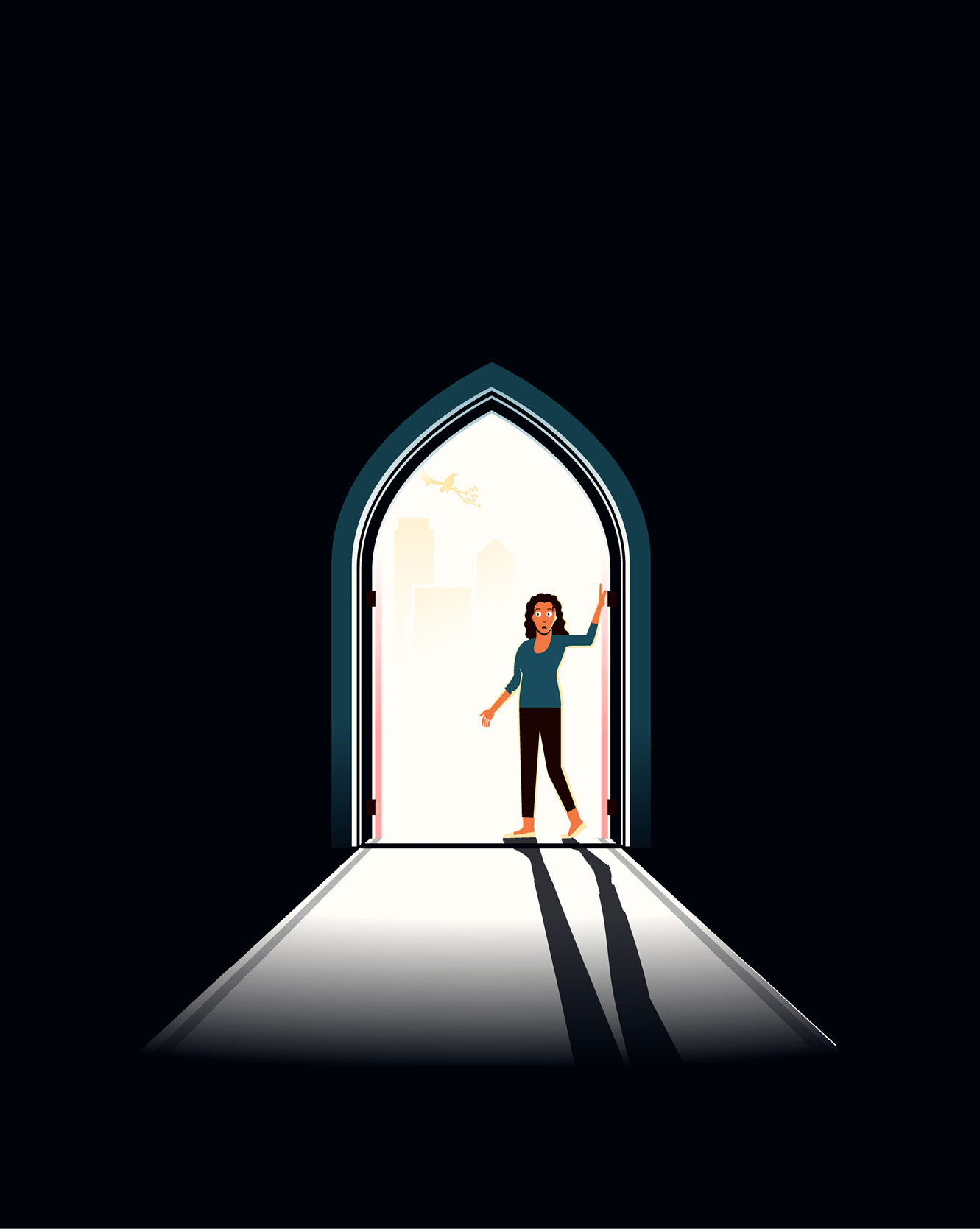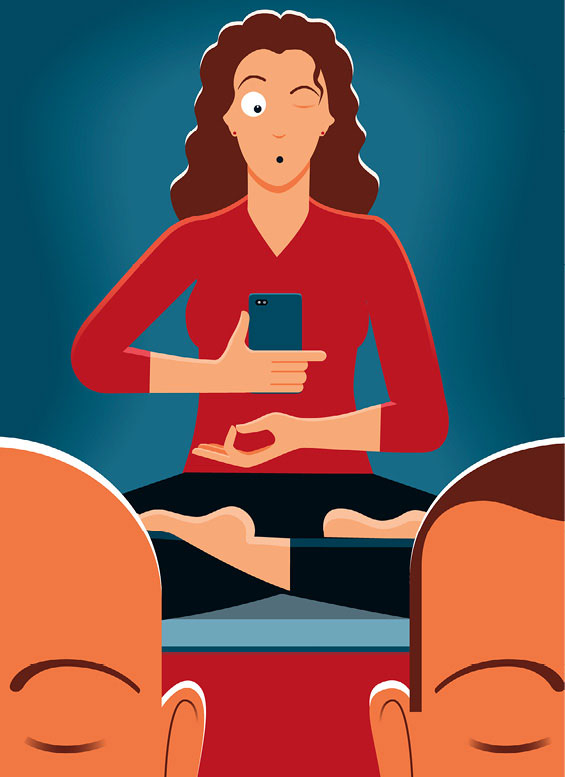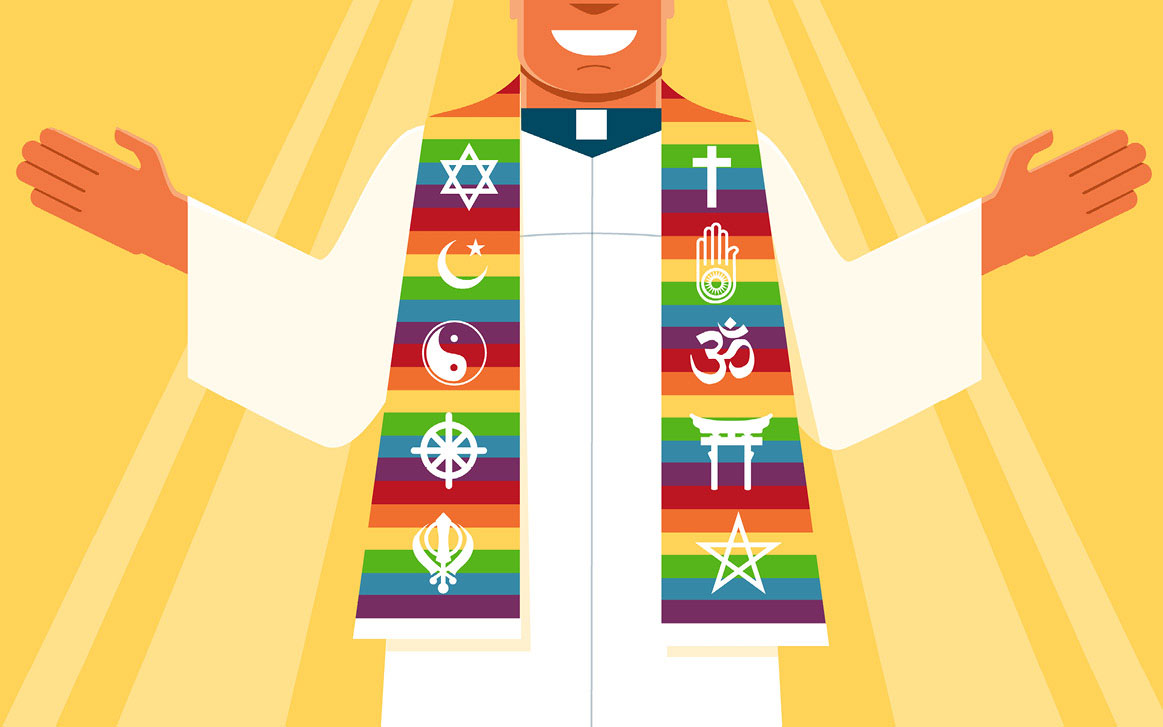Six monks in saffron-colored robes and one balding man in Adidas sweatpants and a black T-shirt sit in front of me on the ground, cross-legged, in complete silence. No one scratches their shaved head or shifts their weight. They are completely still and have been for almost 15 minutes. Prior to the stillness, they had chanted in Pali, an ancient Buddhist language, for 30 minutes. It’s Friday at 7 p.m.
You can do it, I tell myself. Don’t give in to the temptation. Just sit here and think happy thoughts. Live in the moment. Try to relax.
My willpower fails me, and I quietly slither my hand into my bag for my cellphone, careful I don’t accidentally activate Siri. I am seated behind everyone. The others can hear me, but not see me. I text my fiancé about what time we can see the movie Get Out later that night, “like” a high school acquaintance’s engagement on Facebook and snap a photo of the monks. I slide my cellphone back into my purse, only to reach for it again two minutes later. I wiggle my bare toes and flex and unflex my feet. I roll my wrists around. I twist a curl of my hair with my index finger.

JOHN TOMAC
As a nonreligious person, I’m on a journey. No, I’m not really searching for God in the philosophical sense. I’ve done that already. My fiancé was raised Catholic and I was raised Jewish, and neither of us thinks much of religion. A kind of spirituality, maybe. Wonder, sure. But organized, dress-up, organized religion is not for us. Still, we’re getting married soon. By the time you read this, if all goes according to plan, we’ll be newlyweds. And I’ve been thinking a lot about how we might raise our hypothetical kids. What will we tell them when they inevitably ask about our beliefs? Will we take them to different services? To answer my own rhetorical questions, I decided to sample a handful of religions, to learn a little about them. Maybe, I figured, I’d learn something about myself, too.
Related: 6 Steps to Discover Your True Self
Words on perseverance, from the Torah…
“A righteous man falls down seven times and gets up.”
I attended Hebrew school as a child, had a B’nai Mitzvah (the coming-of-age ceremony for twins) when I was 13 and celebrated Rosh Hashanah, Hanukkah and Passover, but as far back as I can remember, I never believed in God or a spiritual being of any sort. It just never added up for me—I prefer hard facts and certain truths. In fact, as a young child, I distinctly remember not being afraid of death because I believed medicine would advance so quickly in my lifetime that I would never die. I also remember feeling horribly let down when, at 8 years old, I realized this was in fact not true.
I wouldn’t call myself an atheist. I don’t think it’s likely, but I don’t rule out the possibility of a higher being. The beauty and awe I feel when I hold my 1-year-old niece’s tiny hands or when I looked out over Maui after a long hike give me a tiny twinge, a thought that perhaps we’re part of something greater. But as quickly as it comes, the thought always leaves my mind—so that’s where I’m coming from.
At the Buddhist service, I vacillate between boredom and fascination. I find the chanting peaceful and lulling, and the meditation afterward—restless as it made me—is akin to the calmness I feel after doing an intense workout. The monks all greet me with smiles and kind words. One gives me a copy of the English translation of the chanting so I can follow along, and another invites me to join them for a traditional Thai lunch.

JOHN TOMAC
The temple is stunning. A giant golden Buddha sits in the front of the room above lush, cherry-red carpeting. The walls are plastered with colorful, detailed paintings, and the windows are all intricate stained glass. I fantasize about how the environment would be perfect for writing—it’s simultaneously calm and overflowing with what feels like creative energy.
But—full honesty here—the meditation drives me mad. I feel restless and instead of going blank, my mind races. I decide that if Buddhism is for me, I will have to do some serious meditation training and learn to detach better from my material possessions, starting with my cellphone.
Words on love, from Buddhism…
“You, yourself, as much as anybody in the entire universe, deserve your love and affection.”
***
The first place of worship I visit for my spirituality experiment is a small Reform Jewish temple close to my apartment in North Dallas. Because I was raised Jewish, I wanted to begin my exploration with something that felt familiar. Despite not believing in God, the culture associated with Judaism—eating lox, bagels and gefilte fish with family for weekend brunch; attending Passover Seder when I’m in town—is still very much a part of my life.
After arriving for the Saturday morning service and taking a seat in the very back—what would become my routine at every stop—I notice a short, blonde girl with thick glasses and curly hair on the stage with a walker. Molly is celebrating her Bat Mitzvah and would be leading the morning’s prayers.
Toward the beginning of the service, Molly’s mother and father, both tall, with slightly graying roots, walk onstage to give a speech to celebrate their daughter. They discuss how Molly—who I gather from bits and pieces of their speech has cerebral palsy—consistently surprises them with her tenacity, kindness and intellect.
“You’ll actually shush us when NPR is on because you want to hear the story,” her mom says, laughing. “And we don’t go any place where you don’t meet a stranger. You get into an elevator, and in two floors, you have new friends and dinner plans.”
Despite having not been to temple in many years, the Hebrew words of the Kedushah prayer flow out of me easily. My calves move reflexively when it’s time to stand and sit. The ease with which the rituals come back to me reminds me of how I still know the lyrics to every song on the ‘90s Alternative Pandora station. Some things never leave you.

JOHN TOMAC
Toward the end of the service, I tune out and focus on the two 12-year-olds in front of me. The girl has unruly dark brown curls and pale skin. The boy has blondish hair and keeps turning his head and shaking his knee. They remind me of my twin brother and me. Memories of Hebrew school fill my mind: the boy who always held his desk up and said he was a cow with udders, the old teacher who always fell asleep and drooled on himself, the times we were lucky enough to get apples and honey as a snack. I smile.
After the service I call my brother, who lives in Chicago, to chat about his job and my upcoming visit home. We laugh as we recount childhood memories. Then I call my father, who is the most religious person in our family. He is overflowing with joy at the news that I attended temple.
I gently break it to him that this was a one-time thing.
***
A confession: The thought of visiting a mosque made me more anxious than any other religious visit on my list. Not because of Islam itself, but because I feared looking out of place without a head covering. What would I do when everyone prayed? What should I wear? A friend of a co-worker told me how to act and dress, so thankfully I knew what to expect when I attended the Jummah prayer at a mosque in the Dallas suburbs one Friday afternoon. Jummah is the most important prayer of the week for Muslims, the time when the mosque is busiest.
As I walk up to the cream and teal building, I learn there are two separate entrances—one for women and one for men. A sign says all new visitors should enter through the men’s door. My palms are sweaty. Outside, about 30 women wait to enter the service. I am the only one without a headscarf. I dressed modestly, though my dress has a scoop-neck collar, so I repeatedly tug my jean jacket closed.
A man in a white SUV yells at me from his window. He’s wearing what appears to be a security guard outfit and a hat that says “NRA” in large yellow letters. He tells me I cannot observe prayer today and that I have to come back at a less busy time. I ask him why, and he fumbles over an answer. I ignore him and walk inside wondering how common encounters like that are.
I head to the visitors’ desk, and a petite woman with perfect skin and big brown eyes welcomes me. I ask her if it’s OK for me to observe prayer today. She smiles and says of course, leads me upstairs and asks me to remove my gold sandals. I enter the prayer room, which has a window allowing the women to see the men below, but not for the men to see us.
I relax once I see 10 or so young children laughing and running around. I sit in the back of the room, and immediately a 60-something woman in a teal sari comes up, shoots me a wide smile and grabs my hand. “Welcome,” she says. A few minutes later, another woman approaches me with her young son. Her name is Uzma, and she spends the next 20 minutes chatting with me about why she moved here from Shreveport, Louisiana, and how she is looking for a job—she’s a psychiatrist. We both miss the entire sermon being broadcast on the TVs in our room. (I record the sermon, though, so I can listen to it later.)
Uzma smiles, a touch of her black hair peeking through her floral headscarf, and tells me about Islam—how its foundation is similar to Christianity and Judaism, how it doesn’t approve of socializing between men and women for pleasure (she doesn’t abide by that rule), why its attire is modest and why men and women pray separately. She says that after the sermon, everyone will pray. She laughs, saying the poses are kind of like doing yoga.
Words on kindness, from the Quran…
“And do not let your dislikes of a people lead you to be unjust.”
I sit cross-legged in the back of the room as everyone prays. I’m dripping in sweat (my long sleeves and layers do not make the best outfit for an 80-degree Texas day). Afterward, Uzma hands me an emerald-green book imprinted with gold text—a copy of the Quran—and shares her phone number with me in case I have any questions. Back in my car, I take off my jacket and leggings, which made my outfit modest. Lost in thought about how pleasant my conversation with Uzma was, I pull my Prius forward to leave, unaware of the long wooden parking block in front of me.
The middle of my car is stuck on the wooden plank. I floor the engine. Nothing. I attempt to reverse. Nothing. There’s a metaphor here, I’m sure, but I’m too embarrassed to think of it at the moment.
Two young men who had attended the service get out of their car and try to help. “My mom did this in her Honda Civic a few weeks ago. Don’t worry,” one man reassures me. I blush at my now somewhat immodest outfit. A third man approaches the scene, also looking to help me solve the problem. They finally come up with a solution—one of them will reverse my car while two of them push and I stand atop the wooden plank to keep it steady. I’m giggling with nervousness as others in the parking lot look on. Their plan works.
I thank them over and over, get into my car and smile to myself. A lot of people stereotype Islam as vitriolic and hateful, but I experienced nothing but warmth, kindness and generosity from its followers.
Related: The Right Way to Be Generous
***
I decide to get a taste of something completely different next: a Unitarian Universalist church. With around 1,000 congregations in the world, Unitarian Universalism is a liberal, forward-thinking, truth-seeking, humanist church. They have many agnostics and atheists among their ranks and robust membership from the LGBTQ community.
Words on acceptance, from Unitarian Universalism…
“Resistance is what love looks like in the face of hatred. Resistance is what love looks like in the face of violence.”
The service begins with a Charles Bukowski poem, “The Genius of the Crowd,” read by a female minister who has short brown hair and wears a rainbow stole. I have always been a fan of Bukowski but never imagined I’d hear his poetry in a religious service.
Those who preach god, need god
those who preach peace do not have peace
those who preach peace do not have love.
The male minister then follows with his sermon, which places more of an emphasis on personal growth than religion. It’s Palm Sunday, a time for the story of Easter. The minister discusses how Jesus—who Unitarians generally believe was an ordinary man and nothing more—entered Jerusalem on a donkey instead of a chariot.
“The message from those who know the story is that Jesus was coming to be a different leader,” he says. “A kingdom that was softer and built on humility; love, rather than on might. We should admit, before we continue on this sermon, that none of us will end up riding into Jerusalem on a donkey or a chariot. We probably will not be hailed as victors or expected to do great things. The closest thing that I think comes to our arriving in fanfare and then dealing with the letdown of reality might be arriving for Thanksgiving dinner at our family’s homes.”
The congregation laughs.
The Easter story teaches us about humility, the minister says. Imagine if our political leaders were humble. “Imagine if Beyoncé rode into the White House on a bicycle and not in a limo,” he says, and the whole congregation bursts out laughing. “A guy can dream.”
My eyes scan the room throughout the service and I see countless interracial and gay couples seated together, hands intertwined. The ceremony concludes with the following words: “More than one person in this church has felt abandoned by the people they loved and felt at home here.”
This feels like such an incredible contrast to the separation and modesty at the mosque. I realize that these people seem to share values—equality and tolerance—and it excites something inside of me.
Related: 6 Essential Traits of Good Character
***
At one point, my fiancé indulges me and joins for a trip to a megachurch. One of those massive congregations, with live adult baptisms on camera and a preacher who gets on TV by making controversial comments. But having a security guard with a headset on standing a few feet away, staring at us on and off, made us pretty uncomfortable. So did the messages in the sermon, frankly. So we left, agreeing that we’d probably never come back, and me hoping for a better experience with the Catholics.
On a cold, rainy Friday, I head to Cathedral Shrine of the Virgin of Guadalupe in downtown Dallas. The red-brick edifice, built in 1898, looks out of place amid the metal and glass of a modern city.
I show up for noon Mass during Lent. I walk in and see nearly 60 people have attended the service. I leave my sopping umbrella at the door, sit on a wooden pew and look upward. The walls are painted white and are surrounded by golden crown molding and colorful stained-glass windows. The ceiling is at least 40 feet high. I imagine it would be a beautiful place to get married.
The service begins, and everyone follows along as naturally as I did at Jewish temple. No prayer book or instructions are necessary. Everyone knows exactly what to say and do. It never occurred to me how comforting that can feel.
In the priest’s sermon, he suggests that although it might be difficult, we must always remember to put the son of God before our own son in times of trouble. God should always come first. As a nonbeliever, that’s a tough concept for me wrap my head around. I flip through the pamphlet I picked up on the way in, which includes a calendar of events for the indoctrinated. I feel very much like an outsider.
I glance up and people have begun to take communion, something I had witnessed many years ago when I went to a Mexican church. I am surprised how everyone shares the same wine cup, but am later told the cloth used to wipe the rim has disinfectant qualities. (I’m still suspicious.) Everyone moves down the line in perfect rhythm: bow head, open mouth, eat wafer, sip wine, make the sign of the cross. I watch, mesmerized by the sheer theatrics of it all.

JOHN TOMAC
Though I don’t connect with the sermon, I like that the people here seem to have a unified rhythm and harmony. I see men in business suits and women in perfectly fitting sheath dresses, as well as two people in wheelchairs and a handful of homeless people. They all sit next to each other; no judgment, no awkward glances, united by their faith. Some part of me longs to fit in so well somewhere.
***
Since college, I’ve had a small silver ring with a quote from the late Carl Sagan, the cosmologist and astrophysicist, inscribed on it: “For small creatures such as we, the vastness is bearable only through love.”
Every so often, like most people, I’ll have a brief period of existential panic when I think of death and the finality of it. When the thoughts become too overwhelming, I think of this quote and it calms me. I don’t believe there is anything after death, so while I’m alive, I will relish and cultivate strong, healthy, lasting relationships with those I love.
That’s what I want for our children. It’s what I want for my marriage, too.
My brief foray into religion, as you might have expected, did not light a spiritual flame inside of me. I did not connect to any of the religions I observed on a deep level. But I did learn to appreciate religion in a way I hadn’t before. I’m embarrassed to admit that, before my journey, I was somewhat anti-religion. I realize now that I subconsciously judged people who were devout. I thought that there must be something wrong with them, something lacking. Which is ironic, I realize, because that judgment was a result of something lacking in me.
Words on patience, from the Bible…
“The end of something is better than its beginning. Patience is better than pride.”
Everywhere I went, I met people communing and praying and looking for peace, all for their own, different reasons. Uzma attended mosque for the socialization it offered her in a town where she knew no one. The Unitarian Universalist church was a safe place for families that have been marginalized elsewhere. The Jewish temple and Catholic church were places of ritual and the comfort of familiarity. Every place I visited was full of people striving to improve themselves and the lives of their families.
You don’t have to believe in God to know there’s something good in that.
Related: 29 Beautiful Stories That Will Restore Your Faith in Humanity
This article originally appeared in the July 2017 issue of SUCCESS magazine.









